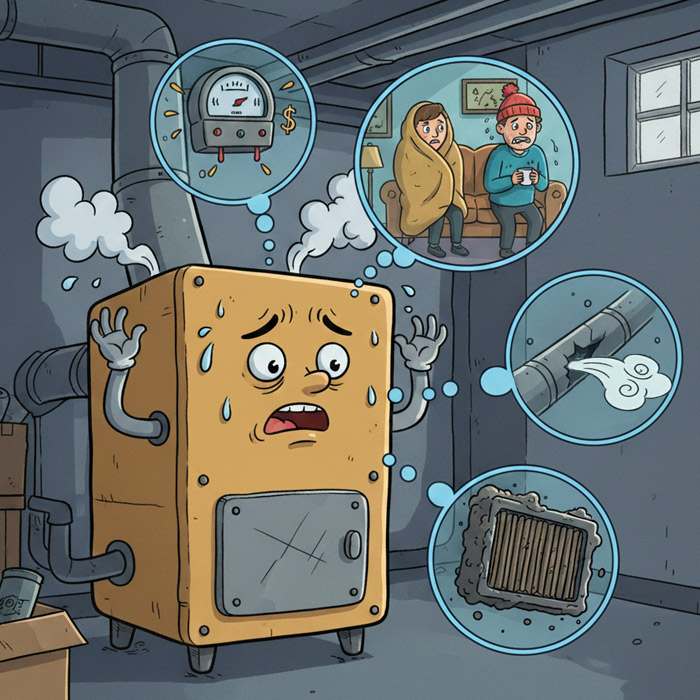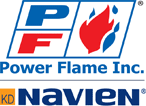
An inefficient heater costs money and affects comfort. Knowing how to spot signs of a heating system that's wasting energy can help you act quickly. This guide can help you spot issues and learn what remedies are available.
Symptoms of a Heater that is Wasting Energy
Cold spots throughout your home or commercial building often indicate heating inefficiency. Some rooms feel freezing while others become uncomfortably warm. This uneven distribution forces your system to work harder, consuming extra energy without improving comfort levels.
Temperature fluctuations happen when ductwork develops leaks or insulation fails. Air escapes before reaching its destination, leaving certain areas underheated. Meanwhile, your furnace or heat pump continues running, trying to compensate for the lost warmth.
Drafts near windows, doors, or vents reveal another common issue. These air currents suggest gaps in your building envelope or problems with your heating distribution system. Even small openings can waste significant energy over time.
Monthly heating costs that jump unexpectedly, when utility costs have not risen in general, often signal system inefficiency. When usage patterns remain consistent but bills keep climbing, your equipment likely struggles with internal problems or external factors affecting performance.
Comparing current bills to previous years helps identify concerning trends. A 15-20% increase without major weather changes, general price increases, or usage modifications suggests your system needs attention. These gradual increases often go unnoticed until they become substantial.
Utility companies have been raising rates, but dramatic spikes can often indicate equipment issues. Worn components, dirty filters, or aging systems consume more energy while producing less heat. This inefficiency compounds over time, leading to increasingly expensive monthly bills.
Heating systems should operate quietly and smoothly. Banging, rattling, or grinding noises indicate mechanical problems that reduce efficiency. These sounds often signal loose components, worn bearings, or debris interfering with normal operation.
Frequent cycling on and off suggests your system can't maintain desired temperatures efficiently. Short cycling wastes energy during startup while failing to heat your building adequately. This behavior typically results from oversized equipment, thermostat problems, or airflow restrictions.
Unusual odors during operation can indicate several efficiency-robbing issues. Burning smells might suggest electrical problems or overheating components. Musty odors could signal moisture problems affecting system performance. Gas odors require immediate professional attention for safety reasons.
Heating systems that waste energy often struggle to maintain proper indoor air quality. Excessive dust accumulation happens when filters become clogged or ductwork develops problems. Poor filtration forces your system to work harder while circulating contaminated air.
Humidity levels that feel uncomfortable indicate system inefficiency. Overly dry air during winter suggests your heating equipment isn't operating optimally. Some systems include humidity control features that stop working when other components fail.
Stale or stuffy air throughout your building reveals ventilation problems. Proper air circulation requires balanced airflow, which becomes impossible when ducts leak or fans malfunction. These issues force your heating system to compensate, wasting energy in the process.
Heating systems older than 15-20 years typically operate less efficiently than modern alternatives. Older equipment lacks advanced features that optimize energy consumption. Components wear out gradually, reducing performance while increasing operating costs.
Dirty or clogged filters represent one of the most common efficiency killers. Restricted airflow forces your system to work harder, consuming extra energy while delivering poor results. Most filters need replacement every 1-3 months during heating season.
Neglected maintenance allows small problems to become major efficiency drains. Dirty coils, worn belts, and low refrigerant levels all reduce system performance. Regular professional maintenance prevents these issues while keeping your equipment running efficiently.
Inaccurate thermostats cause heating systems to waste significant energy. When temperature sensors fail, your equipment might run continuously or cycle inappropriately. This leads to uncomfortable conditions and higher energy consumption.
Programmable thermostats that aren't properly configured waste energy through poor scheduling. Many people set temperatures too high or forget to adjust settings for different times of day. Simple programming changes can reduce energy waste substantially.
Manual thermostats without programmable features often contribute to energy waste. People forget to adjust temperatures when leaving home or going to bed. Smart thermostats can automate these adjustments, reducing waste while maintaining comfort.
How to Fix a Heating System That's Wasting Energy
Professional maintenance addresses many efficiency problems quickly and affordably. Annual tune-ups include cleaning, adjustments, and component inspections that restore optimal performance. This preventive approach costs less than emergency repairs while reducing energy waste.
Filter replacement represents the simplest efficiency improvement most people can handle themselves. High-quality filters improve airflow while protecting system components from damage. Regular replacement schedules prevent efficiency loss from clogged filters.
Ductwork sealing eliminates air leaks that waste heated air before it reaches living areas. Professional duct sealing can improve efficiency by 20-30% in many buildings. This investment typically pays for itself through reduced energy bills within a few years.
Insulation improvements help heating systems work more efficiently by reducing heat loss. Adding insulation to attics, basements, and crawl spaces keeps heated air inside where it belongs. This reduces the workload on your heating equipment while improving comfort.
When to Call a Heating Contractor
Complex efficiency problems require professional diagnosis and repair. Refrigerant leaks, electrical issues, and mechanical failures need expert attention to fix properly. Attempting DIY repairs on these problems often makes situations worse while voiding warranties.
System replacement becomes necessary when repair costs exceed equipment value. Modern heating systems operate much more efficiently than older models. The energy savings from new equipment often offset replacement costs over time.
Energy audits help identify all sources of waste throughout your building. Professional auditors use specialized equipment to find problems that aren't obvious during casual inspection. These comprehensive evaluations provide roadmaps for improving efficiency systematically.
Recognizing heating system energy waste early prevents small problems from becoming expensive disasters. Temperature inconsistencies, rising bills, strange noises, and poor air quality all signal efficiency issues that need attention. Simple solutions like filter changes and thermostat adjustments can provide immediate improvements, while professional maintenance and repairs address more complex problems. Taking action when warning signs appear saves money while keeping your building comfortable throughout the heating season.


